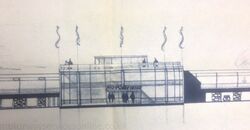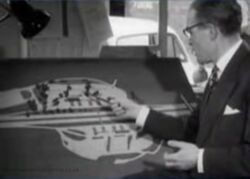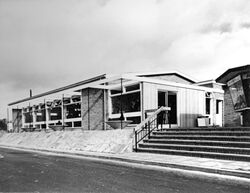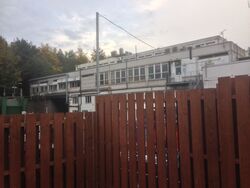The Original Five
It's well established that the oldest motorway service area can be found on the M1, but there has always been some confusion over exactly which one it is. This page aims to put an end to the misinformation which has made its way onto government websites, television documentaries and even the M1's own birthday celebrations, and at the same time tell the remarkable story of how the British motorway service station really was created.
Investigating the Options

It was early 1958 and the opening of the first section of the M1 was set to revolutionise travel between London and The Midlands. There had been a "large number of enquiries" from businesses who wanted to serve the new road, a prospect described as "extremely lucrative", but the whole point of the M1 was that it was supposed to avoid the safety risks and congestion caused by frequent side-turnings. Besides, we were about to celebrate a new era in transport, so we needed to keep anyone who could sully its reputation far away.
Despite these misgivings, the government had included a clause. The Special Roads Act, which would regulate the new motorways, allowed for "service stations or other buildings or facilities to be used in connection with the construction of the special road or its use or maintenance". A "service station", in this context, was imagining a small garage rather than the large facilities we have today.
No progress was made until hauliers started stressing that they couldn't use the new M1 without having safe places to stop. There were also concerns that the new road would be littered with broken vehicles in need of repair. Most importantly for the government, it had been pointed out that roadside restaurants were a "big income stream" in the USA.
With this in mind, it was decided the government would address all concerns by buying land and leasing it to approved operators. Five possible sites for rest areas were identified in July 1958. These were:
- SA1: Redbourn between what's now J9 and J10
- SA2: Toddington between what's now J11 and J12
- SA3: Newport Pagnell between what's now J14 and J15
- SA4: Rothersthorpe (Northampton) between what's now J15 and J16
- SA5: Watford (Watford Gap), the most famous of them all, between what's now J16 and J17
Note that the road would start at what's now J5 and end at what's now J18. The SA Numbering System went on to be continued by most service stations over the following 20 years.
These suggested sites were all 15 miles apart. David Lawrence, the original service station researcher, writes that this was because Roman soldiers would travel 15 miles between breaks.
With no idea how businesses would feel about setting up on this unprecedented design of road, 300 interested catering and motoring firms were sent a questionnaire asking which of the five sites they would prefer, what facilities they would provide, and what regulations they felt would be appropriate. The Ministry planned to take the two most popular locations and develop them in more detail.
67 replies were received, with most proposing breakdown, repair and first aid facilities, and asking for a long lease of up to 99 years. Some of the more unusual ideas came from Wall's ice cream, who would have been happy with a kiosk at Redbourn and Watford Gap, and from a firm called Motorinns, who were proposing five motels so large they would have left no space for anything else.
Amongst those replies were two now-familiar names: Northamptonshire-based recovery firm Blue Boar, and a proposed partnership between Fortes and Blue Star. Both had come up with their first proposals for a new design of transport café, the latter's predictably being more lavish.
Not so well-known was the most popular location: Redbourn had received the most votes, with Watford Gap in second place. Nervous businesses evidently felt more trade would be found at the two ends of the road rather than in the middle of nowhere.
Armed with this information, the Ministry decided that the new M1 should have service areas at Redbourn and Watford Gap. This left a large gap between facilities, so it was decided a small petrol station would be built at Newport Pagnell too. The remaining two sites would be bought but left empty until traffic levels required them.
It has been reported many times that British service stations were inspired by visits to those in Italy, Germany and North America. This is true, but their influence is exaggerated. Between the mid-1950s and mid-1970s many government foreign service station comparison trips were made, but they were mostly interested in the highway design and legal arrangements, rather than copying their building design.
Panic Stations

The whole creation of the service station had been an afterthought, and things were already going wrong: objections from local residents meant the land at Redbourn couldn't be purchased. Rather than waste more time dealing with amendments and appeals, Redbourn was formally dropped from the plans.
This left just two confirmed sites and a further two reserve sites. These sites were all deliberately tiny: the Ministry were worried that anything larger would be mostly empty. That was perhaps their biggest mistake yet.
By now it was April 1959 and work on the motorway had not only started; it wasn't far from completion. For vanity if nothing else, the government were keen to get the road open as quickly as possible. A revised list of firms interested in designing the first service area now stood at 64. Documents explaining the chosen sites and regulations were sent to them all, and those firms were asked to propose a site design and a rent formula, which would be analysed by experts in finance, catering, business and highway design. The Ministry would pay for the landscaping and parking areas only.
Based on the feedback the Ministry had received, the emphasis of each service area would be on providing vehicles with somewhere to be repaired and refuelled. Restaurants would be there as an income stream. Each site needed to have two transport cafés as well as a café or restaurant, at least 12 pumps across 3 islands with at least two fuel brands, as well as 12 toilets, all to cater for the 16,000 vehicles a day which were expected to be using the new road.
The responses to these invitations are explained in detail on the Newport Pagnell and Watford Gap pages, but in short both sites received an impressive proposal from Motorway Services Ltd, the legal name for the partnership between Blue Star and Fortes. They were given a run for their money at Watford Gap by Blue Boar, who had the added selling point that they would be able to recover broken down vehicles from the motorway efficiently using their existing base on Daventry Road.
Ministry of Transport, 1959
It has been suggested many times that Blue Boar won Watford Gap as compensation for them losing existing trade to the new motorway. Hundreds of businesses along the A5 faced that problem, but Blue Boar were the only one to come forward with a realistic proposal for a motorway facility. They won the bid fair and square. The government spotted an opportunity to play on the fact they were helping a disadvantaged local firm, and thanks to that political spin, a myth was born.
The other reason Blue Boar were a good choice was that the Fortes/Blue Star favourites had suggested something which would impress the highest class of motorist. If that market share turned out not to exist, both service stations would have been a commercial failure and that would be a problem for the government, who were being paid a turnover-based rent. Blue Boar's proposal was about providing basic catering to working-class lorry drivers.
It is not true to suggest that one was designed for cars and the other for lorries, but the motorway service station as a concept was still an experiment and the two operators who had been selected each had completely different ideas of what tired motorway drivers would look like.
Date-Check

The new owners of the two service areas had been chosen, but their plans had to get through a lot more hurdles before they could be considered complete. The date was now September 1959, the motorway was expected to open in two months time, and the motorway's contractors hadn't even been told where the car parks were supposed to be. Panic was about to become an emergency.
The two operators were asked to drop everything and instead work on urgent plans to get something ready to open with the motorway in November. Faced with the very real prospect of having to sell fuel from jerry cans, Blue Star (Newport Pagnell) managed to get something described as "reasonably attractive" open in time with a recovery truck, a small filling station and a temporary toilet block.
Blue Boar (Watford Gap) decided it would be easier if they built something which could be adapted into their final plan. They went on to be hampered by poor weather, failed deliveries and expensive earthworks, and were able to offer only fuel when the motorway opened on 2 November 1959. The toilet block opened a full two weeks later. Despite its reputation for being the oldest service station in the country, Watford Gap was two weeks late to the party. When it did open, its makeshift arrangement was described as "dull and depressing".
No rent was charged during this temporary period.
Borrowed Time
The motorway was open and it had toilets to be used. Remarkably, hiding behind all their publicity about how great the motorway was, the Ministry managed to avoid any complaints about the lack of food or the delayed opening of the toilets. But that was a temporary situation and it was time to get the real plans going.
An agreement was reached that the permanent service areas would be complete in April 1960. That goal was missed and this time the Ministry were to blame as designs were slow to be approved and car parks were slow to be constructed. The actual opening dates were as follows:
Newport Pagnell visitor book, 1960
- 15 August 1960: Newport Pagnell northbound café
- 17 August 1960: Newport Pagnell northbound restaurant
- 13 September 1960: Watford Gap northbound, and footbridge
- 30 September 1960: Newport Pagnell southbound café
- 1 October 1960: Watford Gap southbound café
Through August and September an agreement was reached which saw southbound traffic at Newport Pagnell use the rear access so they could park in the northbound car park, as the footbridge wasn't ready.
Note that Newport Pagnell, which is often said to have come second to Watford Gap, once again beat it to the title of opening first.
The new service areas were free to open whenever they liked, but chose to be open 24 hours, as they expected a lot of overnight HGV trade. They were free to apply for a licence to serve alcohol with food: Watford Gap wasn't interested but Newport Pagnell did try. Their application was rejected and attracted considerable negative publicity.
A Grave Error

By the Autumn of 1960 the new service areas were open. It is quite shocking then that by November 1960, Motorway Services Ltd were requesting permission to extend Newport Pagnell.
The service areas had been built on the assumption that one in seven cars passing them would stop. The actual figure was one in four. Fortes' prestige and Blue Boar's rudimentary catering arrangements were both big hits with their two target audiences and they were unable to keep up with demand.
To add to the problems, another panic-stricken late change to policy had seen maintenance compounds placed next to service areas where land had been severed by road construction but wasn't being used. At Newport Pagnell, no such land was available, so it was taken from the tiny acreage reserved for the service area. Despite that, the Ministry were unhappy that their costs had spiralled, as what was built was somehow larger than what they had expected.
Meanwhile, much bigger problems had arisen away from the M1. Back in 1959, design work on parts of the M2, M5 and M6 were at an advanced stage. They had been hoping to learn lessons about service stations from the M1 but with nothing open, they had to nervously copy the existing strategy. The only mistake they accepted was that their wording about footbridges needed to be more clear, otherwise, their attitude was that "there is no data to show that our policy was wrong".
As a result, eight more severely undersized service areas were created. It is from this mould of panic that much of the service station as we know it was formed.
Back on the M1, the overcrowding at Newport Pagnell had reached another state of crisis and Redbourn was still off the cards, so a quick study of suitable sites concluded Toddington needed to be built quickly. Toddington was promoted internally as an overflow for Newport Pagnell. The other reserve site at Rothersthorpe opened in 1977.
Legacy
Service station design meeting, 1972
When asked about motorway service area in the 1960s, people will often talk about bold architecture and fine-dining restaurants. These followed the Newport Pagnell model, and Keele was actually described as "an improved Newport Pagnell". However, this style was a novelty that very quickly went out of fashion, and most service areas since have copied the utilitarian style of Watford Gap. Those two both have their original buildings, but the original parts are largely hidden away.
Being a few miles from the northern end of Britain's only major motorway made Watford Gap a memorable reference point. This, coupled with its catering and atmosphere being more suited to the lorry drivers and young men who's lives were changed most by the new road, has made Watford Gap the more famous of the original two. For a long time it was Britain's busiest service area.
In terms of policy, the approach used on the M1 was used again to build a significant number of the service stations in the UK, but over time almost every regulation and policy has changed. Some of the first changes were allowing only one brand of fuel to be sold, banning alcohol and buying much larger plots of land.
The early design of service stations would go on to receive widespread criticism, and be a source of embarrassment for the government. Key moments include the Bartlett Review into building design (commissioned in 1965) and the Prior Report which covered regulations (published in 1978). In practice though, as far as the customer would notice, service areas would be dominated by no-frills cafés, like the Watford Gap model, until the 1990s.
The history of the original five service areas is explored in more detail on their respective pages, and readers interested in this subject may also like to read about Forton, Leicester Forest East, Strensham, Keele, Charnock Richard, Knutsford and Farthing Corner.